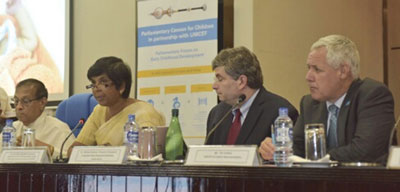Investing in children spurs strong and healthy economic growth, says UNICEF expert
View(s):Early childhood investments integrate health, education, nutrition, stimulation and protection. Good nutrition nourishes the brain during the sensitive periods of development while stimulation and enrichment spark neural connections, increasing the brain’s capacity and function, according to a globally-acknowledged expert economist and researcher.

Dr. Michael Samson (second from right) at the Sri Lanka Parliamentary discussion
These comments were made by Dr. Michael Samson, Director of Research at the South- African-based Economic Policy Research Institute (EPRI) during a presentation to a group of Sri Lankan MPs and in a brief interview with the Business Times during a short visit to Sri Lanka organised by UNICEF last week.
In Parliament, he met the members of the Sri Lanka Parliamentary Caucus for Children, addressing them during a special “Parliamentary Forum on Early Childhood” with Speaker Karu Jayasuriya in the chair. Dr. Samson is best known as the author of the British Medical Journal (BMJ) Global Health Paper titled ‘Cognitive capital, equity and child sensitive social protection Asia and the Pacific”. UNICEF Sri Lanka Representative Tim Sutton was associated in these meetings.
Explaining why cognitive capital is essential in the development of a child, he suggested that Sri Lanka needs comprehensive and integrated approaches – ministries working together to achieve a better impact in for example, linking maternal nutrition programmes to health and maternal care practices initiatives; innovative synergy-creating programmes—including parental care interventions; integrating nutrition programmes across sectors to multiply impact; strengthening youth development opportunities and providing well-resourced facilities for young children, with water and sanitation and other vital services.
While saying that parliamentarians led by Speaker Mr. Jayasuriya welcomed the presentation and acknowledged that investing in children should be a priority for any administration, Dr. Samson told the Business Times that pre-school education is one key component of early childhood investment.
Early childhood investment promotes inclusive growth, he said citing examples from the Mauritius where in the 1950s it was like any other country. However an integrated social policy enabled restructuring of the economy onto an inclusive high-growth path and today Mauritius is a global leader in early childhood investment.
That country is among those with the lowest poverty rates in the world, and amongst the highest economic growth rates over the past several decades, he said, citing another positive example from Malaysia where the number of working age people per child tripled in 2016 from 1960 because of investments in children.
Sri Lanka, he noted, has grown robustly (as measured here by GDP per capita—in US$ PPP terms), particularly over the past two decades but incomes lag the East Asian “miracle” countries.
Dr. Samson said: “Malaysia’s average income in the 1960s was about twice that of Sri Lanka. Sri Lanka and Malaysia—like many countries—experienced an economic growth ‘take-off’ once average per capita incomes comfortably exceeded the poverty threshold. But a 1960s to 2016 year-by-year comparison is misleading—Sri Lanka started at a lower level. Comparing apples-to-apples—from the year in which average incomes comfortably exceed poverty levels—Sri Lanka has grown faster and more steadily than Malaysia.”
In comparison, Singapore grew nearly twice as fast as both countries once it achieved the above-poverty threshold.
“Why? Many reasons, but one is that it invested substantially, comprehensively and cross-sectorally in early childhood. And that growth has compounded for decades longer—driving Singapore’s current prosperity, resilience to shocks, and ability to navigate the demographic challenges ahead,” he said.
The number of working age people per older person has more than halved in Singapore from 1990 to 2016, and is expected to halve again from 2016 to 2050. The number of working age people per older person has about halved in Sri Lanka from 1990 to 2016, and is expected to halve again from 2016 to 2050, he added.
Recent medical research documents the role of social protection in building “cognitive capital”. In the past year, leading medical research authorities have done something that their academic medical journals rarely do — they have weighed in on global economic policy with a common theme: ‘Investing in children is the most productive pathway to long-term economic prosperity’, he said.
Investments in children, Dr. Samson noted, builds the cognitive capital that enables children to reach their full potential while building the assets that today drive the wealth of nations.
Impaired cognitive development leads to high mortality rate and increase risk of adult chronic disease while investing in children delivers children’s rights, builds strong and healthy families and promotes child well-being. It’s the right thing to do, he says.
Furthermore investing in children—linking health, nutrition, education, social protection, child protection, water and sanitation, and other sectors—goes further: it builds cognitive capital which today is the foundation of the wealth of nations, he added.
(Feizal)


